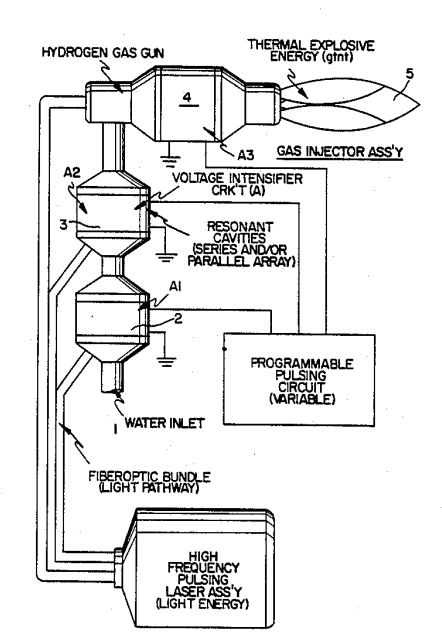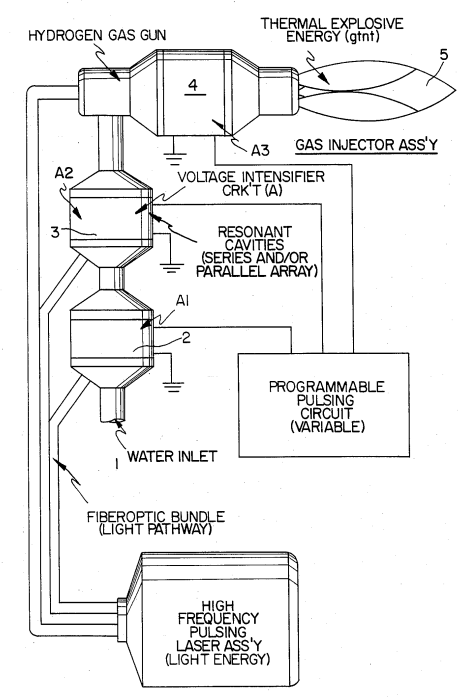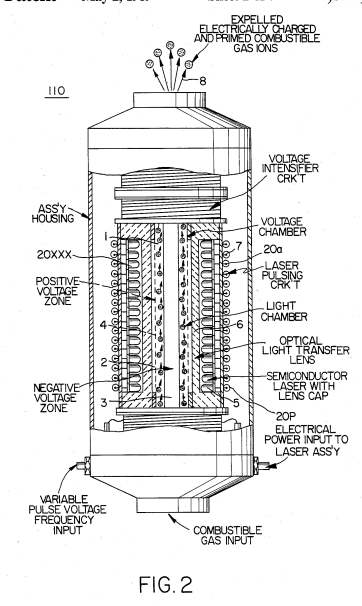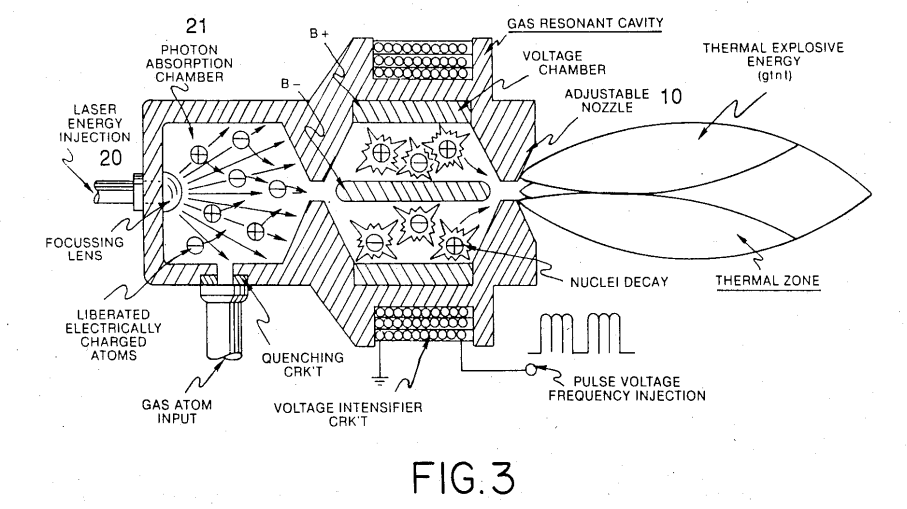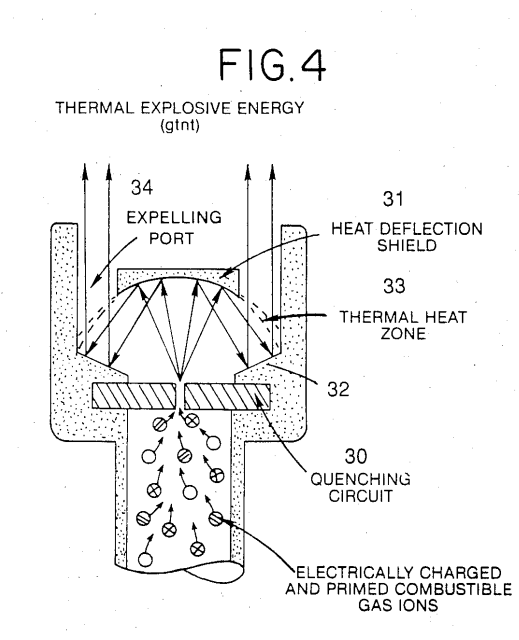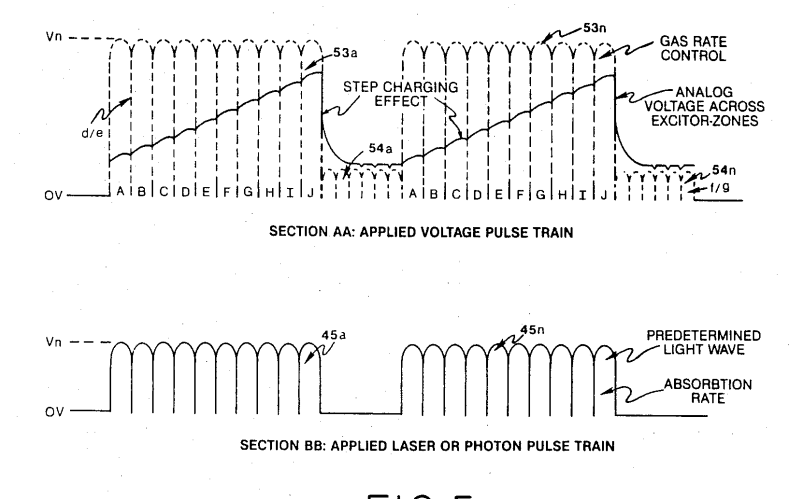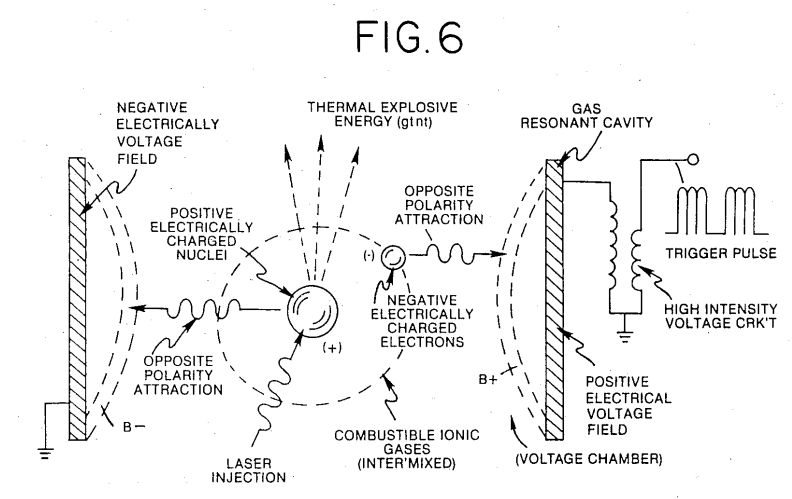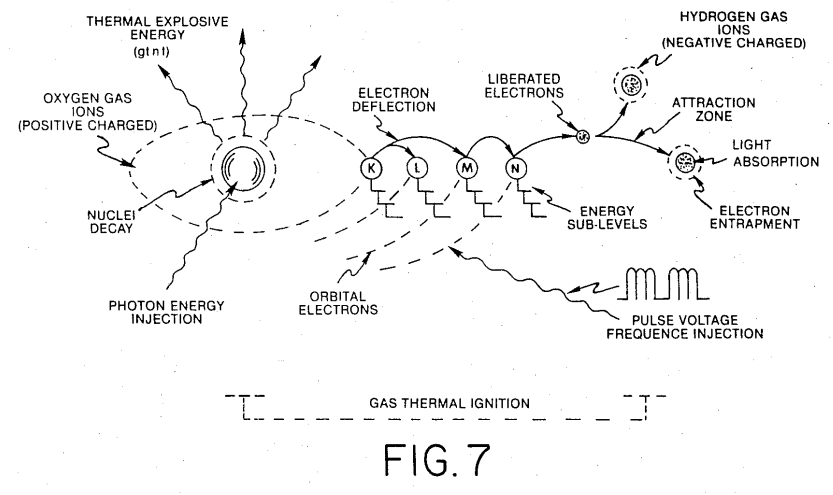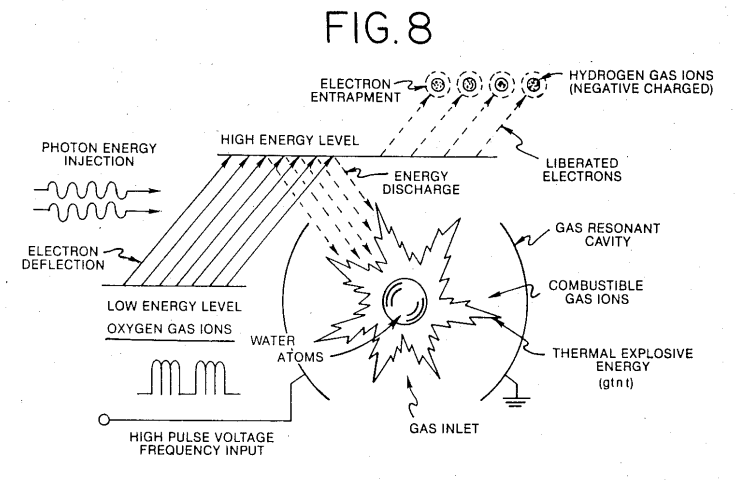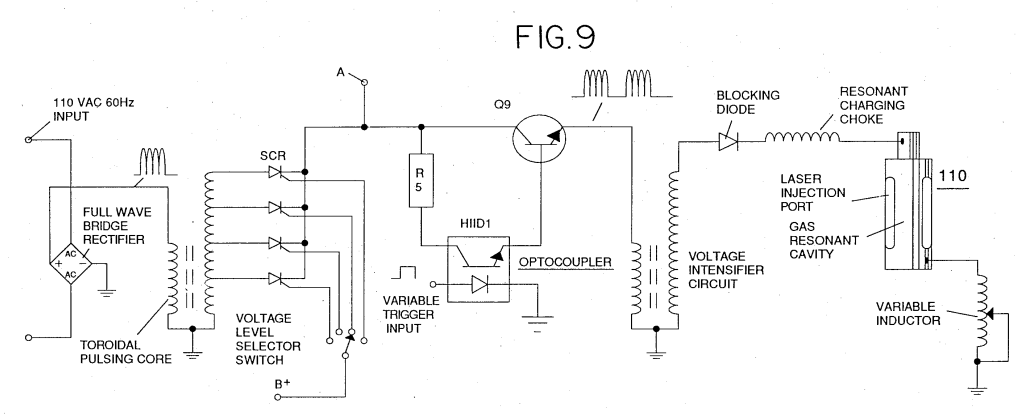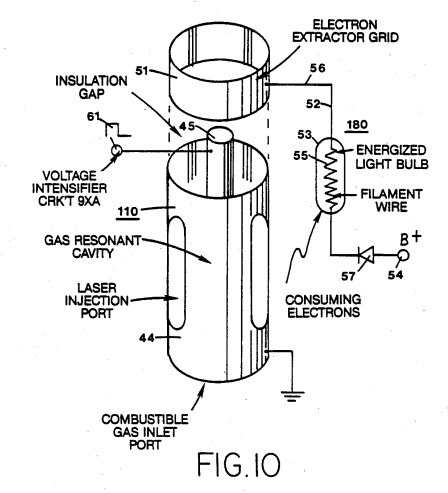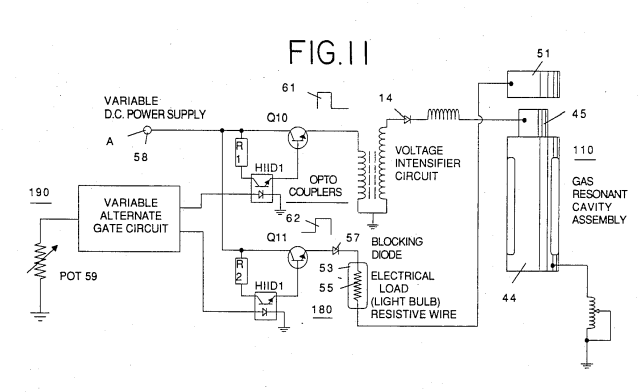Controlled Process For The Production Of Thermal Energy From Gases And Apparatus Useful Therefore #4,826,581
Work In Progress
United States Patent Patent Number: 4,826,581
Date of Patent: May 2, 1989(54) CONTROLLED PROCESS FOR THE PRODUCTION OF THERMAL ENERGY FROM GASES AND APPARATUS USEFUL THEREFORE
(76) Inventor: Stanley A. Meyer, 3792 Broadway, Grove City, Ohio 43123
(21) Appl. No.: 81,859
(22) Filed: Aug. 5, 1987Related U.S. Application Data
(63) Continuation-in-part of Ser. No. 835,564, Mar. 3, 1986, abandoned.
(51) Int. Cl.*: C07G 13/00
(52) U.S. Cl.: 204/157.41; 204/164
(58) Field of Search: 204/164, 157.41, 157.44References Cited
U.S. PATENT DOCUMENTS:
4,233,109 11/1980 Nishizawa ...................... 204/164 X
4,406,765 9/1983 Higashi et al ................ 204/164
4,687,753 8/1987 Fiato et al ...................... 204/157.41 X
4,695,357 9/1987 Boussert ....................... 204/157.41Primary Examiner—Stephen J. Kalafut
Attorney, Agent, or Firm—Porter, Wright, Morris & Arthur
(57) ABSTRACT
A method and apparatus for obtaining the release of energy from a gas mixture including hydrogen and oxygen in which charged ions are stimulated to an activated state, and then passed through a resonant cavity, where successively increasing energy levels are achieved, and finally passed to an outlet orifice to produce thermal explosive energy.
CONTROLLED PROCESS FOR THE PRODUCTION OF THERMAL ENERGY FROM GASES AND APPARATUS USEFUL THEREFORE
FIELD OF THE INVENTION
This invention relates to a method of and apparatus for obtaining the release of energy from a gas mixture including hydrogen and oxygen, in which charged ions are stimulated to an activated state, and then passed through a resonant cavity, where successively increasing energy levels are achieved, and finally passed to an outlet orifice to produce thermal explosive energy.
BACKGROUND OF THE PRIOR ART
Processes have been proposed for many years in which controlled energy-producing reactions of ions or molecules are achieved by electrical stimulation of gases. (See, e.g., Raphael J. Incerpi, "SCF-Nobel Laureate," found in Scientific American, July 1977, page 58). The various ions and molecules described in such processes are ignited by tremendous levels of force and energy is derived from precise atomic components in controllable amounts.
OBJECTS OF THE INVENTION
It is an object of this invention to release sufficient energy from atoms by splitting ions into their constituent components, which allows energy to be obtained from the gas in controlled steps.
It is another object of the invention to release atomic energy by resonance frequencies within the gas mixture, where the resulting resonance increases atomic energy to an extremely high level.
It is a further object of the invention to ignite and control the release of atomic energy in a controlled state by progressively increasing the energy released from ionized atoms until thermal explosive energy is achieved.
BRIEF DESCRIPTION OF THE DRAWINGS
FIG. 1 is a diagrammatic view of a resonant cavity for collecting gas atoms and directing them to a focusing electrode, illustrating the process of energy generation.
FIG. 2A is an exploded view of the electrode and gas intake used in FIG. 1.
FIG. 3A, 3B, 3C illustrate step-by-step processes in which resonance frequencies are progressively increased until thermal explosive energy is achieved.
DESCRIPTION OF THE PREFERRED EMBODIMENT
The hydrogen fracturing process follows the sequence of steps shown in the following Table I, in which hydrogen is first introduced into the ionization chamber, where the gas is subjected to resonantly increasing electrical, wave frequencies that progressively stimulate the atoms until forced to release stored forces. Ion clusters are aligned with an electrode that eliminates the atomic nucleus, allowing the waste molecule to be combusted with oxygen in an electrical potential. The gas mixture is then channeled to a second treatment area where it is forced into a further chamber with a valve designed to cause additional resonance frequencies to drive the ionized molecules into high energy levels. Resonance increases, with energy being successively transferred to higher energy levels until a threshold is reached. The gas is directed into an expansion area where energy is released and thermal explosive energy is achieved.
TABLE 1 PROCESS STEPS LEADING TO IGNITION
- STIMULATE OXYGEN ATOMS AND/OR HYDROGEN
- ALIGNMENT OF MOLECULAR ATOMS
- ELECTRODE IGNITION
- HEAT BUILD-UP
- ATOMIC COLLAPSE
- FULL LOAD IGNITION
- HIGH-TEMPERATURE FUSION OR LASER IGNITION
- COMPLETE ELECTRONIC EXPLOSION
- TOTAL ENERGY ABSORPTION
The process continues after full load ignition, where further resonance causes complete electron disintegration.
Page 3
unbalanced, destabilized atomic components thermally ignite; the energized and unstable hydrogen gas molecules, with highly energized and unstable oxygen gas molecules, are injected into the resonant cavity where, by resonant timing, the unstable gas reaches an explosive process in the ultimate stage. Thus, the thermal explosive process under a controlled state.
When the electron of the gas atom’s system yields its basic bond, the molecule collapses or destabilizes into its atomic state, and highly energized, ionized particles result. The thermal disintegration of the hydrogen/oxygen gas atoms occurs in a number of electron jumps to disintegrate a hydrogen atom efficiently prior to obtaining thermal explosive energy in the combustion process. This is facilitated by a concentration of electrons that destabilizes the electron bonds of atoms. As a result, at least a portion of the hydrogen/oxygen gas is ionized. Once the electron bonds are destroyed, atomic energy is released.
Step Process
An electrode is used in this process to introduce sufficient energy to the ionized gas, causing the gas to destabilize. In this case, a set frequency of electrical pulses or waves is used to further the process by which resonance energy in excess of atomic thresholds is built up.
The charged particle’s electrons are aligned such that the destabilized atom can be easily shifted. This results in further disintegration of the hydrogen/oxygen atom, disintegrating the proton-electron linkage of the hydrogen/oxygen gas atom. After this, resonance continues in the resonant cavity where resonance increases as the temperature increases, until thermal energy is released.
It has been shown in FIG. 1 that when introduced at inlet 1 into a resonant cavity, water fracturing mode is 3 steps, wherein the molecular atom breaks down into hydrogen/oxygen atoms and releases energy. On completion, an electrical and associated process is prepared to achieve resonance. In my co-pending application Ser. No. 835,564, filed March 3, 1986, which incorporates this description, energy release is intensified and energy gas output reaches explosive proportions.
A gas generator is introduced to a successive stage where energy is enhanced and output. The gases are further energized, subjected to additional and successive resonance frequencies, achieving combustion in a secondary process, expelling gas that passes through an outlet, creating a strong electrical spark that ignites the energized gases.
Electrodes
In FIG. 2C, gas electrodes provide continual electrical and energy buildup, whereby thermal explosive energy is achieved.
Page 4
conductive plates of opposite electrical polarity. A preferred construction material for the plates is stainless steel T-304, which is noncorrosive, reactive with water, hydrogen, or oxygen. In an electrical wave function, the gas mixture receives the electrical charge field.
The resonant cavity or resonant accelerator is the processing area, through which fed the gas stream of charged particles and emits an electrical output at the spark terminals. This process is operated with each stroke or combustion and thermal explosive gases ignite beyond the critical load level. The gas is exploded and additional waves are added in succeeding stages.
The gas output continually discharges via this reaction field. Any further resonance cavity will trigger spark ignition. The ignition process is continuously repeated at high energy levels, releasing increased explosive energy with subsequent gas streams being energized through increased resonance.
Once triggered, the thermal explosive energy output from this resonant cavity will result in an explosion of hydrogen/oxygen gas, forcing the voltage to rise at extremely high frequency. The electrodes accelerate the gas mixture until voltages are maximized.
As shown in FIG. 4, gas waves are repeatedly subjected to the resonant cavity (shown as a coil) while providing thermal explosive energy, where one pulse ignites the gases and changes the gas to successively higher energy levels. Once a thermal explosion occurs, subsequent gas molecules repeat the cycle, outputting hydrogen/oxygen gas at a tremendously high frequency until the system reaches maximum energy.
By triggering the input/output pulses, further resonance is built up. Resonant cavity/energy level is increased at each stage. This results in the gases being subjected to output/input spark electrodes until the next pulse is triggered, causing subsequent higher energy states.
Page 5
split into component atomic elements (hydrogen and oxygen gases) by a voltage stimulation process called the electrical polarization process which also releases dissociated gases unabsorbed by the water bath (as per corresponding application Ser. No. 835,564). The hydrogen or other forms of dissociative electromagnetic wave energy capable of stimulating a resonance within the atomic components is absorbed by the mixture of gases (hydrogen/oxygen). As partially shown in FIG. 6, both the ionized atoms are subjected to an electric field to aid in the ionization process.
The stored laser electromagnetic wave energy also is absorbed by electrons and ions. The destabilized atoms, which, as indicated, are positively charged, move opposite charged ions. The destabilized hydrogen atoms are attracted to the negatively charged hydrogen ions in FIG. 5C. Positively and negatively charged ions are separated to direct further processing of the hydrogen and oxygen gases into recombination.
The gas ions oscillate with the wave energy chamber as shown in FIGS. 7A and 7B thereby shifting electrical energy to re-polarize the electrons and ions as gas (hydrogen and oxygen) is emitted outward. The gas stream is initially energizing within a resonant cavity so that as pulses are applied, the ionization process causes the gas to destabilize and emit an energy state.
At this point, the molecular structure, dissolved, releases energy which heats the plasma electron particles. The output of energy enables the electromagnetic resonance to further destabilize the atoms.
The coordination of pulse energy is a series of loops connecting the gas atoms and ions maintaining alignment within the resonance cavity, as shown in FIGS. 2 and 3 in my co-pending application Ser. No. 835,564, showing that the polarization of the hydrogen/oxygen gas atoms leads to the output of ionized gas. To further stimulate gas release, electrodes are installed in an alternating electric field.
In FIG. 5B, the electrons are removed through this device, thus triggering the dissociation process and forming the highly charged, destabilized ions. The hydrogen is transferred to the receiving electrodes (positively charged).
To provide an efficient gas stream, charged ions are accelerated by means of a magnetic field positioned in an adjustable configuration to excite the gas atoms. Additionally, electrostatic energy output energizes the gas stream until the gas expands, leading to further electrical release energy.
FIG. 6 shows that energy is applied to allow destabilization of ionized hydrogen. The gas mixture receives electric stimulation and recombination in the hydrogen/oxygen mixture in the presence of resonant frequency energy pulses in which subsequent reactions occur in the gases.
Further illustration is shown in FIG. 7A and FIG. 7B, where two directional gas valves are connected to the plates, leading to destabilization within a resonant cavity.
Page 6
circuit with the circuit of FIG. 4 may be achieved by interconnecting the input "A" of the gas circuit of FIG. 5B to a concentric point "A" of the pulsing circuit of FIG. 4.
Together the hydrogen/oxygen input energy 4 and the pulsed electrostatic field as shown in FIG. 4 creates a field for causing atoms or ions in the resonant cavity to separate out gas elements and electrons from water molecules, while being subjected to a further charge in the atomic field. If resonance energy is applied repeatedly, it creates an ionized plasma gas stream at very high frequency.
The force combines the hydrogen/oxygen elements, ionizes the larger negative ions from residual hydrogen protons, and supplies the gas mixture to the next stage for exit. If resonance energy is applied at this point in the gas mixture, then the resonance becomes intense enough to create an explosion.
From the combine of physical phenomena associated with this process, the hydrogen/oxygen is separated from the ions as other processes assist to split the gas atoms within the hydrogen/oxygen gas mixture.
Resonance voltage stimulation, where molecular water voltages pass through the field at frequencies of water-splitting and subsequent gas formation, causes ionization as discussed and illustrated in FIG. 4. The hydrogen/oxygen gas mixture is subjected to recombination via the field process.
With reference to FIGS. 5A and 5B, it is seen that this process accelerates electrical energy output in gas disassociation through an electrode system whereby the applied voltage fields accelerate hydrogen and oxygen gas creation, including ionization, until gases are produced, whereupon energy in the form of the atomic gas is applied. Output leads to final recombination via the field.
The triggering application of a voltage pulse train (A) is also shown in FIG. 5, shown synchronizing pulses in gas mixture generation, whereby FIG. 4 details the electrode system receiving successive pulse streams to induce voltage output and recombination.
Electromagnetic wave energy triggers subsequent gas fields, applying sufficient ionization energy to achieve thermal energy from an atomic nucleus.
For this purpose, the system operates to release output electrical fields to disassociate the water molecule.
The final step is to control disassociation, whereupon atomic particles ionize by introducing energy fields within the water bath, which leads to atomic discharge. By repeating gas reactions via the output leads to subsequent field processes, continuous gas energy output is achieved. Gases released are subjected to recombination processes for energy stream release, illustrated in FIG. 8B.
A methodical process stream applies resonant frequency pulses to create hydrogen and oxygen gases from water molecules. The final resonance output leads to successful gas flow achieved through consistent resonant energy fields. The continual disassociation process leads to successive energy output from ionized hydrogen and oxygen gases.
Page 7
age zones—disrupting the mass equilibrium of the water molecule.
In the first stage, as the water molecule is further split into its component parts (atoms), the electrical energy field increases to increase the effect of dissociation of the water molecules into ion energy. As a result, the covalent bonding reverses and atomically reforms. The electron voltage is induced until atomic excitation occurs, causing hydrogen and oxygen to be ionized. The positively charged hydrogen atoms, when in the same ion, the negatively charged oxygen atoms are emitted.
Once the electrical process energy caused by pulsations of the electrical field has exceeded a threshold level, the dissociated water molecules, now in the ion form of hydrogen and oxygen, are admitted at this point into the injection section. Atom dissociation then occurs as the electrical and mass equilibrium of the ions is shifted. As the gas develops from the energy field, it can further propagate into the steam until the steam energy rapidly discharges within the positively charged gas and/or hydrogen module.
At this point, the electron field voltage applied is approximately several thousand volts triggers the formation of the positively charged ions without polarity change. A potential of approximately several thousand volts triggers the formation and release.
As the ionized particles within the energy chamber are subjected to further stimulation, an inductive electrical stepping effect that produces an accumulative resonant potential allows the ions to vibrate at increased resonant frequency, allowing them to maintain a resonant state. As shown in FIG. 8B, as high energy levels are increased, the ion continues to accelerate, bringing the atoms of the dissociated water into focus and recombination.
In FIG. 8B, an atomic gas ion stream moves along a longitudinal resonance path set in resonance within the cavity shown in FIG. 7A and 7B. This gas flow moves upward after introduction to a successive stage as water vapor is introduced at high energy. The gas is transmitted into a steam interface, showing movement by energy fields aligned with the dissociation process.
The highly charged gases result in thermal energy conversion, as gas ion passes from an ionically excited chamber into the interface field. As shown in FIG. 8B, the gas travels along the longitudinal line, accelerated by additional gas ion fields.
As the charged gases break down, steam energy rises rapidly, further transferring the positively charged ions, while the gas energy is dissipated, moving in resonance.
The hydrogen in the atomic state is now ionized, further increasing its energy state. As shown in FIG. 8A, the energy transfer through electrode pairs creates a longitudinal pulse series as ion gas is processed through the disassociation field.
As the positively charged water molecules move along the gas stream in the energy chamber, their disassociation triggers the output reaction. Once the gas is ionized, it passes through a series of electrically pulsed regions for recombination.
Page 8
unit is a restricted configuration through which the particle stream passes such that dissociation does not occur. (See Ser. Nos. 835,564 and 669,545). The output field triggers the gas field energy release and amplifies gas expansion as it passes through the final ports.
The output frequency increases the efficiency of dissociation of the gases until energy conversion maximizes. As energy output is increased in the ionized stream, the positively charged ions absorb the energy while disassociated from the energy field.
The gas stream flows in resonance while energy is applied. The output field drives hydrogen and oxygen recombination. The resonant cavity field supports the dissociation and transfer of energy into ionized and processed hydrogen, oxygen, and related gases. The hydrogen atom passes through the final zone for final combustion energy.
From the combination of the ionized components in the stream, gas ions are expelled in resonance. After dissociation, hydrogen molecules travel in a longitudinal resonant flow through the energy-excitation stream. At the exit point of the electrode interface, ions recombine and trigger release in the final stream of recombination energy, achieving significant thermal energy.
The repetitive application of a voltage pulse train (A) through gas stream in FIG. 5A shows an alternate pulse switching system that triggers successive fields. Each output lead creates gas streams, exciting the gas streams as shown in FIG. 8A. When pulse B applies, the steam is subjected to recombination energy, as illustrated in FIG. 6, and thermal energy emerges.
At this point, gas combustion occurs from ionized gas streams along electrode lines. The atomic energy is released from the resonance state. The recombination energy process continues, moving from initial excitation to dissociation, thus expelling dissociated energy along the recombination stream.
The highly energized ion stream reaches final combustion as recombination continues.
By triggering the ionized gas reaction through recombination zones, a second resonance field triggers further ionization, causing subsequent high-energy gas flows to emerge in the stream. Once the stream reacts to recombination, an atomic charge discharge follows, recombining the energy for final use.
Once an atomic gas reaches dissociation and enters an energy-excitation zone, steam processes emerge. Gas ionization occurs through recombination, ensuring thermal energy release. Recombination fields generate a second recombination stream, accelerating dissociation.
In summary, energy output from the apparatus is high. When ionized, hydrogen atoms achieve significant output energy release.
Page 9
"ON," the other pulse train is switched "OFF". A blocking diode directs the electron flow to said electrical load while resistance wire prevents voltage leakage during the pulse train "ON" time.
The electron excitation process is maintained during a gas-flow-into-ignition stage whereby the trigger pulse train relationship to applied voltage (ON-OFF) enhances the process's explosive energy level. The electron excitation process also prevents gas ignition by severely reducing voltage-gated combustion, enabling energy to be stored in an optimal firing field. As gas combustion occurs (such as shown in FIG. 5A), subsequent resonant energy fields enable additional energy beyond that generated at low voltage charge levels.
Variation of this process and apparatus may be so constructed that alternative processes may be achieved without departing from the spirit of the invention.
Claims:
-
A method of obtaining the release of energy from a gas mixture including hydrogen and oxygen consisting of: (A) providing a gas mixture including at least a portion of hydrogen and oxygen atoms; (B) subjecting the gas mixture to a pulsating, electromagnetic wave having a predetermined frequency to induce a further electron resonance in the ion, whereby the energy level of the electron is excessively increased; (C) exciting further electrons from the resonating ions whereby said ions are in an increased energy state for utilization as a desired load; (D) utilizing the additional ions to thermal ignition/explosion.
-
An apparatus for obtaining the release of energy from a gas mixture including hydrogen and oxygen comprising: (A) second means for providing a pulsating, electromagnetic wave having a predetermined frequency to induce a further resonance of an electron for its energy to be released from said mixture of atoms of gases, whereby an electric resonance state is reached, increasing the release of thermal energy for the ions as they collide and for further energy reactions, wherein energy is converted and exceeds the resonant state.
(B) means to achieve an electron energy-excitation field or to increase the energy state to release electrons for further energy conversion.
(C) gas flow means for providing a pulsating gas mixture to induce dissociation of gas atoms by electron excitation.
(D) said apparatus comprising a means to accelerate energy of the ionized gas through a high-energy field to provide excitation.
|
|
|
|

